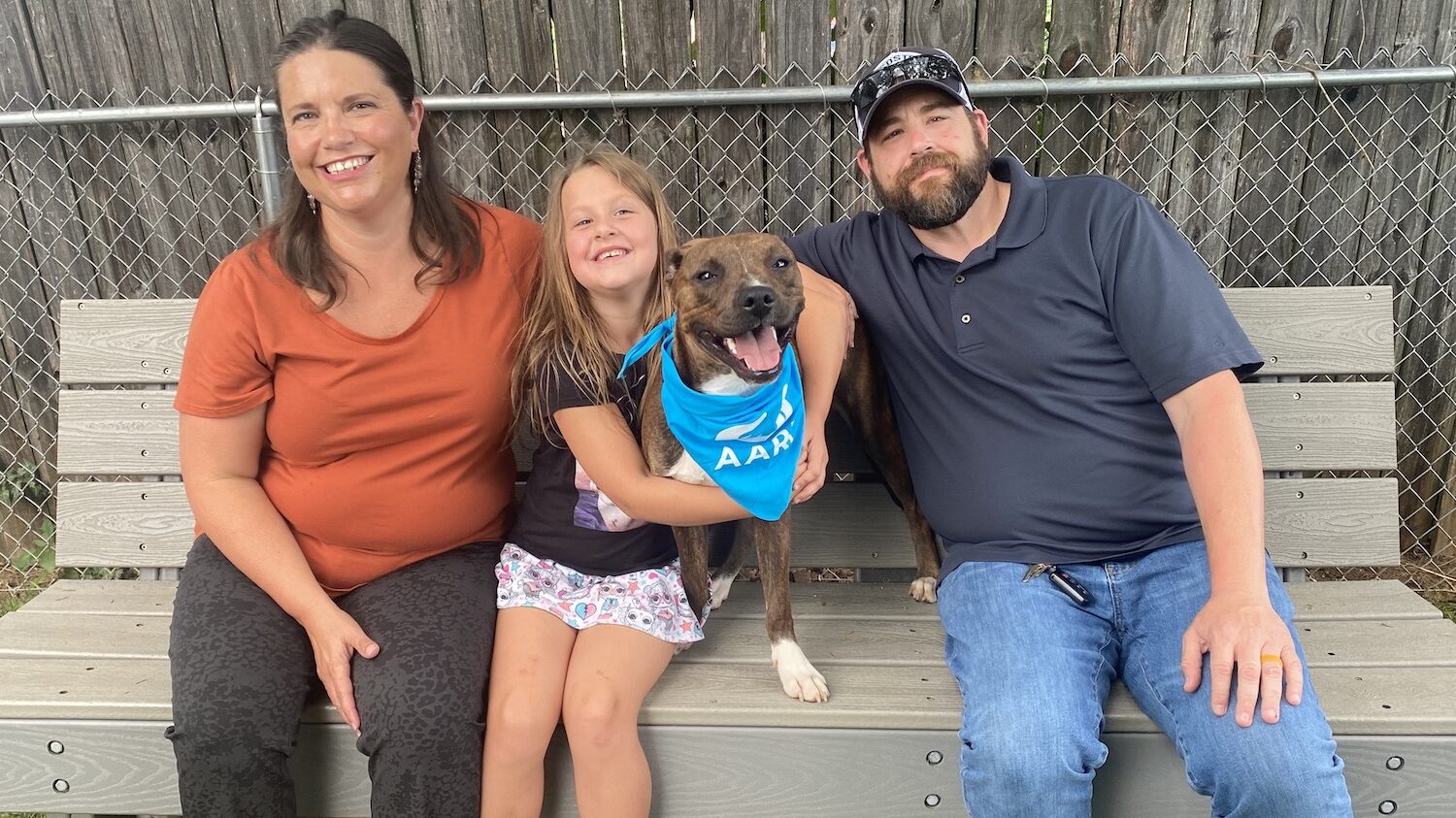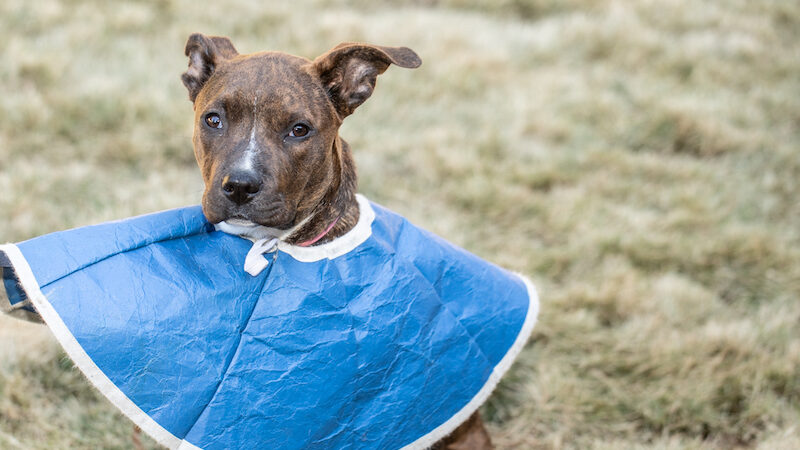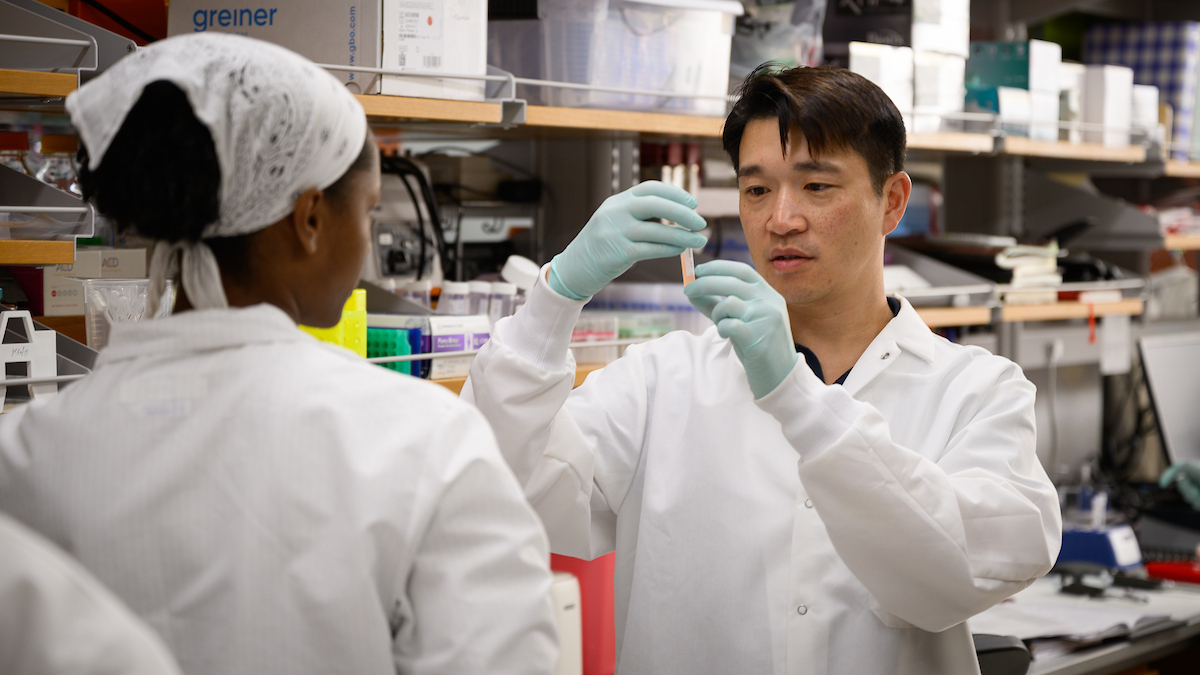Heart to Heart: Following Treatment at NC State, Dog With Heart Murmur Comes Home to Girl With Same Condition

“Heart” was one of the words 7-year-old Ali Mikesell could make out in the ad on her mother’s phone, maybe because heart is a word she has been hearing her whole life.
Both Ali and her mother, Lindsay Mikesell, were born with a ventricular heart defect. Ali still has a heart murmur.
Ali had been scouring pet adoption ads for weeks, looking for a new dog to adopt after Riley, the family’s 14-year-old blue tick/beagle mix, passed away. Lindsay was reluctant to give the child her phone to look at dogs again. She just wasn’t sure the family was ready.
“Then Ali made out the heart thing, so I’m thinking it’s probably heartworms,” Lindsay Mikesell says. “She had already fallen in love with the picture – they put up the cutest picture ever – so I said, ‘Let’s read what it says together.’ She read what she could do, and I filled in the blanks.”
The blanks included that Kallie, the brown American Staffordshire terrier mix with white socks and Yoda ears, had been born with a congenital heart defect.
“And Ali said, ‘Mom, she has a heart murmur! I have a heart murmur!’” Mikesell says.
Now what Kallie and Ali have is each other, thanks to a host of animal lovers affiliated with the Animal Adoption and Rescue Foundation (AARF) in Winston-Salem, N.C., and a team of veterinary cardiologists at NC State Veterinary Hospital, including one key resident who chose her profession because she wanted to help people by healing their animals.
Kallie was born in July 2020 to a pregnant stray at the AARF shelter. Found to have a severe heart murmur caused by patent ductus arteriosus, or PDA, by the shelter’s veterinarian, Kallie likely wouldn’t survive a year without surgery to close a hole in her heart.
Surgery expenses, however, typically aren’t part of a rescue organization’s budget so Kallie was taken in by an AARF foster family to live out her days with love.

The heart defect didn’t keep the puppy from being rambunctious. When Kallie became a bit too energetic for the foster family’s small dog, Kerri Sigler, a lawyer in Pfafftown, N.C., and another AARF foster mom, took Kallie in.
“They alluded to a heart murmur, but I did not understand what that meant for her,” Sigler says. “Once I took a nap, and because Kallie is who she is, she decided she was going to sleep on my face. I was half-awake, thinking who is hammering plywood in my driveway? It was her heart, and I thought someone was building something in my driveway. That was the extent we are talking about.”
Sigler found the way Kallie’s chest heaved after a romp outside terrifying and decided she couldn’t stand to think about Kallie suffering. After researching the surgery Kallie would need to fix her heart, Sigler reached out to the NC State Veterinary Hospital at the recommendation of another AARF volunteer and started raising the money she would need online.
“I raised about $1,000, then my brother texted me and he goes, ‘I’m just going to pay the balance,’” Sigler says, explaining that her brother sometimes likes dogs more than people.
About Thanksgiving 2020, after a trip through the Starbucks drive-through for a dog treat, Sigler dropped off Kallie at the NC State Veterinary Hospital. Cardiology resident Rachel Van Zile led Kallie’s surgery and care.
After an echocardiogram, a heart ultrasound, Kallie’s PDA diagnosis was confirmed.
“If the natural course of disease continued without intervening, usually the animal will go into heart failure by one year of age,” says Van Zile.
In utero, the ductus arteriosus in animals and humans shunts blood through the heart because the lungs aren’t being used. The structure is supposed to close when a baby begins to breathe oxygen after it is born.
“When it stays open, or patent, that is when we diagnose a PDA,” Van Zile says. “It becomes a problem when excessive blood is allowed to flow through the open vessel. Over time, more blood is circulated back through the lungs into the left side of the heart, leading to volume overload and eventually heart failure.”
It was the same scenario for Ali and her mom. Lindsay’s defect was surgically repaired when she was 1 year old, but Ali’s is still being monitored.
“Ali said, ‘Mom, she has a heart murmur! I have a heart murmur!”
For Kallie, Van Zile inserted a cardiac catheter into the femoral artery through a small incision in the dog’s right groin area and then worked it up to the aorta, where she deployed an Amplatz canine ductal occluder, or ACDO.
“It’s a mesh material that looks like a dumbbell, with two disks on either side, and the middle part fills in the vessel or occludes it,” Van Zile says. “The disks sit on either side of the PDA opening, and the middle part occludes the actual flow.”
During surgery, members of the medical team, which included Van Zile as well as an attending veterinary cardiologist, anesthesiologists and cardiac nurses, were watching Kallie’s heart via transesophageal echocardiography and fluoroscopy, which both show the heart beating in real-time.
“Once the animal is under anesthesia, we feed a long, narrow probe down the esophagus,” Van Zile says. “The heart lies right next to the esophagus, allowing us to get beautiful images of the PDA and precisely guide the procedure. We don’t release the ACDO until we make sure it’s in the right spot.”
Van Zile says the improvement in Kallie’s heart was dramatic.
“Her left ventricle and atrium were severely dilated when we first diagnosed her, and she likely would have gone into heart failure in weeks to months if we had not been able to minimally invasively occlude her PDA,” she says. “The day after the procedure, her left atrium had already gone completely back to normal size.”
Kallie has an excellent prognosis.
“It’s one of of those conditions that’s best diagnosed when a dog is a puppy because we can actually fix this congenital heart defect and give them a normal lifespan,” Van Zile says.
The heart incorporates the new structure over the first few months after surgery, she says, but the animal needs to be kept calm and quiet, not words anyone uses to describe Kallie or Sigler’s home.
A former frequent animal foster mom, Sigler says the rescue community refers to her house, which has held as many as nine dogs at once, as “the jungle.” After her surgery, Kallie went home instead to her first foster home, where she stayed crated for about five weeks.

“She was like a shaken soda bottle and needed to play when we brought her back to the jungle and set her loose,” Sigler says. “She had a good ol’ time, knocking over furniture and wreaking havoc.”
When it became time to look for a forever home for Kallie, the Animal Adoption and Rescue Foundation put her picture in an online pet ad and included her heart story so that potential owners would know she might need special care.
After Ali saw the ad, the Mikesells put in their adoption application and had Kallie come live with them in Kernersville.
“I was very, very, very, very happy, so happy I jumped on the couch,” Ali says. “She’s really sweet and she likes me and I like her.”
Sigler couldn’t be more pleased with the outcome for Kallie, both in her new home and her heart.
“NC State became maybe my favorite place on earth,” she says. “They were phenomenal. Her surgeon sent screenshots at 8 that night to let me know she was OK. That blew me away. If you called, they were friendly. I can’t speak highly enough of NC State. I would send anyone there.”
The last Van Zile had heard of Kallie, the dog was still in foster care. Told that Kallie had been adopted by a little girl with the same heart defect, Van Zile was silent a few seconds.
“I’m tearing up a little bit,” she says. “That’s an amazing end to the story, and it was already an amazing story anyway. That’s why I do what I do.”
~Burgetta Eplin Wheeler
- Categories:


